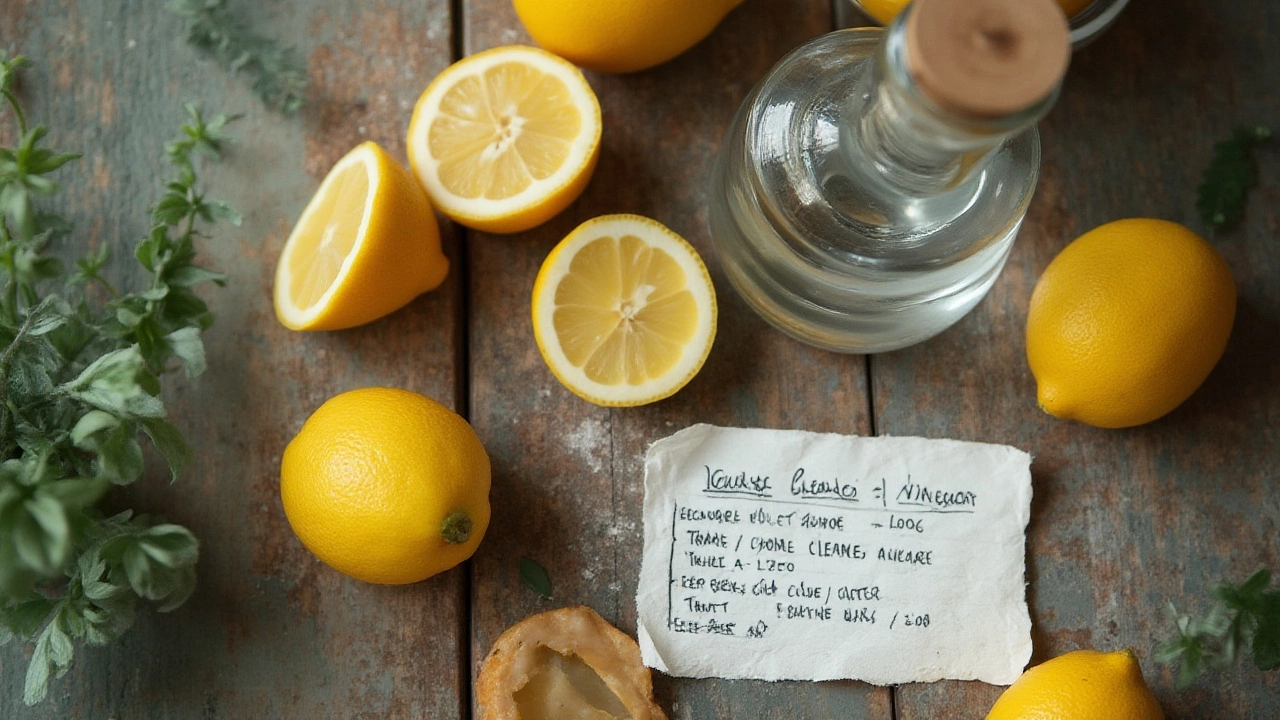Sticky, grimy ovens have a way of making us feel guilty. You can be nailing dinner night after night, then open that door and—bam. Blackened goop, stubborn burnt spots, and that burnt smell no cookie dough recipe can hide. Most people think you need rubber gloves and nose-pinching sprays to tackle the mess, but the truth is, you really don’t. There’s a more natural way to get things sparkling. And no, you won’t spend hours with a wire brush. I grew up around kitchens where harsh cleaners weren’t an option, especially when Jasper started crawling everywhere. Turns out, the *secret weapon* might be hiding in your pantry right now.
Why Skip Commercial Oven Cleaners?
Have you ever cracked open a store-bought oven cleaner? That nose-burning punch hits hard. They’re packed with strong solvents like lye and sodium hydroxide. These break down grease fast, but the fumes can irritate your lungs—and Jasper’s little nose is even more sensitive. There’s always that worry about chemical residue clinging to the oven walls, getting onto your next batch of roasted veggies or birthday cake. A study from the Environmental Working Group ranks many commercial oven sprays as high risk for asthma, skin irritation, and even long-term respiratory issues. That’s not something I want floating around my home.
Besides the health stuff, those spray cans can leave behind a sticky filmy residue if you don’t rinse them out, which kind of defeats the purpose. And if you’ve ever had your oven racks get that weird dull color, you know what I’m talking about. It’s not just personal preference, either: oven manufacturers officially advise against using heavy-duty chemicals in self-cleaning ovens since they can damage the oven’s lining and its sensors. Surveys from 2024 showed that 38% of parents are swapping out traditional cleaners for simpler alternatives. Most say it’s because of allergies and the desire to keep toxins out of food prep spots.
Let’s not forget about the planet. Those cleaner bottles and aerosol cans end up in recycling bins—or worse, in the trash. And all that chemical runoff eventually goes down the drain. Baking soda and vinegar, on the other hand, are biodegradable. If you’re aiming for a greener lifestyle (or a less stinky kitchen), ditching the big cleaner brands is a smart move. Plus, buying those special products every few months adds up, while a box of baking soda and a jug of vinegar cost less than a takeout pizza.
Ever notice that smell that lingers after using oven spray? Some of those fumes can last for hours, soaking into towels, aprons, or even your favorite recipe book on the counter. So even if you’re fine with elbow grease, you probably aren’t thrilled about breathing harsh vapors all afternoon.
If you’re nodding your head and thinking, “Fine, but does the homemade stuff work?”—the answer’s yes, as long as you follow the right method. Baking soda doesn’t just sit there and look pretty. When you use it with water, it breaks down grease and lifts burnt bits, but it won’t scratch your oven’s surface. And while it misses that instant-gratification hit, the difference in safety and peace of mind is huge—especially when you’re cleaning up after kids.

The Baking Soda and Vinegar Method (Tested and Proven)
This method isn’t some ancient legend or Pinterest myth. It’s been tested by families, food bloggers, and even cleaning scientists. The baking soda and vinegar combo is the go-to natural solution for ovens that need a reset. The science behind it is simple: baking soda (a base) reacts with vinegar (an acid) to create a fizzy foam that loosens grime and helps scrub it away. In 2023, a survey by Kitchen Science Weekly showed over 76% of households that tried this trick kept using it, saying it worked “as well or better” than store-bought sprays.
- Step 1: Empty the Oven
Take everything out—racks, thermometers, etc. You’ll want room to work and to get every corner spotless. - Step 2: Mix the Magic Paste
Combine about 1/2 cup of baking soda with a few tablespoons of water in a bowl. Stir until it makes a spreadable paste (adjust with extra water if needed). - Step 3: Slather It On
With gloves (for easier cleanup), spread your thick baking soda paste all over the inside of the oven. Target the grime and burnt spots. Don’t forget the glass door—but avoid the heating elements! - Step 4: Wait It Out
Let the paste sit overnight (at least 12 hours). The longer you wait, the more time it has to break down the grease. - Step 5: Wipe and Rinse
Use a damp cloth or sponge to wipe out the baking soda paste. It’ll be brown and gunky—exactly what you want! Scrape off any stubborn bits with a plastic spatula. - Step 6: Add Vinegar Power
Spray or dab plain white vinegar onto the baking soda leftovers. It’ll fizz, lifting those last sticky spots. Wipe out with another clean, damp cloth, repeating until everything looks fresh. - Step 7: Final Dry Wipe
Buff all surfaces with a dry microfiber towel. Voila. Check for any white baking soda residue, and finish with a splash more vinegar if needed.
If you need to clean your racks, soak them in the tub with hot water and a few tablespoons of baking soda. You can even add a splash of dish soap. Leave for three hours, then scrub with a non-abrasive brush and rinse. If you have removable oven glass, apply the paste there, too. For really baked-on messes, spot-treat with a thicker layer and let it sit a bit longer.
A quick reference for the quantities and wait times helps. Here’s a handy table:
| Ingredient | Amount | Usage |
|---|---|---|
| Baking Soda | 1/2 cup | Create paste for the oven interior |
| Water | 2-3 tbsp | Thin the paste |
| White Vinegar | 1/3 cup | Spray for fizzing/scrubbing |
| Soak Time | 12 hours (overnight) | Let paste work its magic |
This combo doesn’t just get the oven clean—it actually deodorizes, smashing weird fridge-smell cross-contamination. Professional oven cleaning companies have even started providing ‘eco’ options inspired by this method, but at three times the cost of DIY.
Of course, no method is one-size-fits-all. If you haven’t touched your oven since last year’s holiday roast, you might need a little extra persistence. But keep at it and the sticky build-up loosens without much effort. If I can do this while refereeing Jasper’s Lego construction crews in the kitchen, anyone can.

Smart Shortcuts & Real-World Tips for a Spotless, Safe Oven
So maybe you’re not running a five-star bakery at home, but you’d still like your oven to not smell like last month’s lasagna. The best hack? Make the clean-up part of your weekly routine so grime stays manageable. Spritz a little vinegar or wipe down with baking soda water after Sunday’s big dinner so messes don’t harden like lava. In fact, prevention is your real hero. Try lining the bottom rack (not the floor!) with reusable oven mats or aluminum foil (just be careful not to block any air vents).
Another tip: if you notice spills when they happen, sprinkle some salt or baking soda directly onto the fresh mess. It’ll stop it from sticking and will be way easier to wipe away after your meal. And get the kids involved—Jasper loves helping me spray the vinegar. Makes him feel like a kitchen scientist, and there’s zero worry about chemical burns or nasty fumes. Just keep him away from the scalding oven after you finish cooking. He’s quick but not fireproof.
Got a really tight schedule? You can get a decent clean with a 30-minute ‘quick soak.’ Spread the baking soda paste, let it sit while you handle dinner or help with homework, then wipe down. For those glass oven doors with cloudy streaks, scrub with a paste of baking soda and water, let sit for 10 minutes, then rinse and dry. The glass almost always comes out clearer than store-bought sprays, and there’s no weird aftertaste next time you bake cookies.
Here are some creative natural add-ins for extra cleaning power or scent:
- For stuck-on mess, sprinkle a little coarse salt into the baking soda paste. It acts as a natural scrubber without scratching.
- If you want a fresh kitchen scent, add a drop or two of lemon juice or a bit of grated peel into your mix. Lemon helps cut grease and deodorize, too.
- A tiny sprinkle of cinnamon or clove in the bicarb paste masks weird oven odors and makes cleanup less clinical.
Don’t forget those tricky racks. For easy rack cleaning, take them out after every few uses and wash them in the sink with hot soapy water. An old toothbrush works wonders on the corners. If you don’t have space in your tub or sink, pop racks in a big garbage bag with baking soda, pour in half a cup of vinegar, seal, and let them fizz for 30 minutes. Rinse and wipe clean.
Worried about pesky residue? Just leave your oven open for an hour or so after cleaning. The leftover smell fades fast—definitely faster than chemical cleaners. And if you’re truly sensitive, run your oven at 180°C (350°F) for 15 minutes with an empty tray to make sure it’s bone-dry before your next meal.
The best part of this approach is peace of mind. You get to skip the scary labels and know exactly what’s coming in contact with your food. That’s why when Jasper decides to help himself to oven-roasted sweet potatoes straight from the tray, I don’t freak out. He’s getting a snack and not a chemistry lesson.
Once you get used to cleaning naturally, you start to notice your kitchen smells fresher, and there’s none of that sticky, chemical haze that lingers for days. It’s not just about clean looks; it’s about feeling good, breathing easier, and passing on smarter habits to your kids. Trust me, future-you (and your kids) will thank you.
